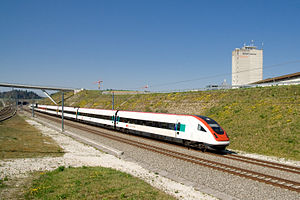- Mattstetten–Rothrist new line
-
Legend

To Zurich 
To Basel 
39.3 Olten (396 m MSL) 
to Solothurn 


Born line on left 


Kessiloch bridge 218 m 


Born / Aarburg tunnels (810 / 87 m) 


43.0 Aarburg-Oftringen (412 m MSL) 


To Lucerne 


From Lucerne 


Aare bridge (319 m) 


A1 bridge (183 m) 


Born line on left 
46.3 56.4 Rothrist (407 m MSL) 
55.2 Rothrist West 


(55.2) New line on right 


(49.2) Murgenthal tunnel (4,745 m) 


Murgenthal (414 m) 


Murgbrücke (223 m) 


(48.2) Aegerten tunnel (657 m) 


Roggwil-Wynau (432 m) 


Aare Seeland mobil to Melchnau 


(42.9) Langenthal tunnel (10,107 m) 


Aare Seeland mobil to Niederbipp 


Langenthal (472 m) 


BLS AG to Huttwil and Wolhusen 


(40.3) Thunstetten tunnel (889 m) 


Bützberg, line moved away from former station 


Badwald wildlife crossing (80 m) 


(36.6) Gishübel tunnel (855 m) 


36.0 Wanzwil 


From Solothurn 


36.0 Connection to Jura foot line 


Solothurn 


To Neuchâtel 


From Solothurn 


Herzogenbuchsee (464 m) 


(33.1) Önzberg tunnel (3,173 m) 


(30.1) Hersiwil tunnel (1,000 m) 


Riedtwil (496 m) 


(24.4) Neuschläg wildlife crossing (60 m) 


Wynigen (527 m) 


Burgdorf tunnel (510 m) 


Grosse Emme-Brücke Burgdorf (55 m) 


Burgdorf (533 m) 


BLS AG to Solothurn 


(19.3) Emmequerungs tunnel (1633 m) 


BLS AG to Hasle-Rüegsau–Langnau/Thun 


(18.4) Rüdtlingen tunnel (Chäs tunnel) (400 m) 


Lyssach 517 m 


(17.1) Birchiwald wildlife crossing (60 m) 


New line on left 


Hindelbank 516 m 





Mattstetten 


12.3 Äspli bei Mattstetten 


Grauholz Tunnel (6,295 m) 


Schönbühl 


From Biel/Bienne 


Zollikofen 


RBS 


Grauholz line branches to the right 
4.9 101.3 Löchligut 
Worblaufen / Worblental (70/206 m) 
To Thun 
Wankdorf 
From Thun, Lötschberg and Interlaken 
103.3 Bern Wylerfeld (Original Bern Station) 
Aare River, Lorraine viaduct (1,150 m) 
Bern 
To Lausanne The Mattstetten–Rothrist new line is Switzerland's fastest railway, running between Mattstetten and Rothrist. It forms most of the Olten–Bern railway line, which makes up over half of the trunk route connecting Switzerland's main city, Zürich and its capital, Bern. The new line opened on 12 December 2004, as the centrepiece of the Rail 2000 project, a comprehensive upgrade of Swiss railways.
The line is almost 52 kilometres (32 mi) long, with one branch. At Wanzwil junction, a 10 kilometres (6.2 mi) upgraded former local line to Solothurn to connects to the rest of the "foot of the Jura" line (to Neuchatel, Yverdon and Geneva). The line has a maximum speed of 200 kilometres (120 mi) per hour and reduced the travel time between major Swiss hubs of Bern, Basel and Zurich to under an hour, allowing the regular interval timetable (German: Taktfahrplan) to be realized, where both express and stopping trains on all lines arrive and leave on the hour at Bern and Zurich stations, allowing a great number of convenient connections. The line was the longest new line built in Switzerland since 1926. Construction began in April 1996[1] and the last piece of rail was put in to place on 30 April 2004 at the Bern-Solothurn canton border at Inkwil on the connection to Solothurn.[2]
The Mattstetten–Rothrist was the first in Switzerland to put the European Train Control System (ETCS) into regular operation. This was originally planned for December 2004 but had to be repeatedly postponed because of technical problems.[3] On 2 July 2006 testing at night was started and trains ran from 22:30 at up to 160 km/h (99 mph) with ETCS; from 23 July testing started at 21:30.[4] Switching from conventional signalling with external signals to in-cab ETCS signalling was successively brought into operation and in 18 March 2007, trains began to run with full ETCS signalling at up to 160 km/h (99 mph); since December 2007 they have run at up to 200 km/h (124 mph). The ETCS trackside equipment consists of a Radio Block Center, the required balises and an electronic interlocking.[5]
References
- ^ "Baubeginn" (in German). Eisenbahntechnische Rundschau 45 (10): 593. 1996.
- ^ "Neubaustrecke Mattstetten–Rothrist fertiggestellt" (in German). Eisenbahntechnische Rundschau 53 (6): 593. 2004.
- ^ "Vorerst nur auf Neubaustrecken" (in German). Neue Zürcher Zeitung. 26 April 2007.
- ^ "ETCS starts well". Today's Railways Europe (129): 57. September 2006.
- ^ European Railway Review (3): 98. 2007.
Categories:- Railway lines in Switzerland
Wikimedia Foundation. 2010.

